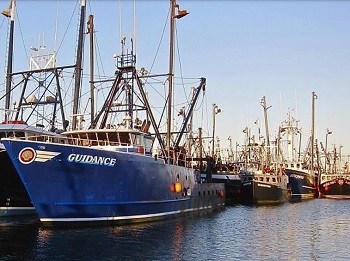Daily Archives: February 22, 2020

A February fishing adventure
Can you imagine spending 15 hours out on Lake Michigan on a day like today? Me neither. But many commercial fishermen here did just that in the mid-20th century, if they could maneuver through the ice floes. Tucked away in the archives of the Kenosha History Center is a letter written by Kenoshan LeRoy Nohling, dated Feb. 14, 1931. LeRoy, 24, related his experience of that week: “Nathan, my cousin, called up about midnight the night before to suggest that as long as neither of us were working, we might as well take a trip on one of the fishing boats here in the harbor. At six in the morning, we were down at the pier looking ‘em over.,, Off to the fishing grounds! >click to read< 19:32
1937 lake tragedy kills Kenoshans on the Marold II – This is the second part of a two-part series. Sunday’s first installment of this month’s Old Kenosha focused on the commercial fishing trade here in 1931 as told by a young man who joined the crew of the Marold II for a day. >click to read<

American Marine launch’s Texas Parks and Wildlife aluminum catamaran patrol boat for State and Federal waters
The 80’ x 27’ (OAL) Captain Murchison features twin CAT C18 ACERT D Engines, with Hamilton Jet HM 521 waterjets and is built to USCG Subchapter T standards. It is also the first vessel in North America to feature Hamilton Jet’s innovative Advanced Vessel Control (AVX) system. The new AVX features include both a station keeping and a JETanchor positioning system. Additional vessel features include a DJI Mavic Drone integrated to the helm displays, as well as a FLIR M400 XR High resolution Thermal Imaging video with tracking to assist with patrol duties in the Gulf of Mexico. The state-of-the-art hydrofoil assisted vessel, from Teknicraft Design, will combine innovative design features critical to modern maritime law enforcement. Video, >click to read< 14:48

If the info comes from some enviro group, its good! Info from the lobster fishermen? Not good!
We’re out fishing for news as always, and we never know what we’ll find. Saw this letter to the editor: Whales, and realized this letter is a by-product of the enviro group anti-fishing campaign.,,, From the letter, In the editorial you say, “According to the Maine Lobstermen’s Association analysis of data …” Seriously? We are going to rely on their analysis to risk the extinction of a highly evolved mammal? The editorial further reads, “Only 8 percent (of right whale deaths) resulted from entanglement in trap or pot fishing gear,,, >click to read< 11:34

New Bedford Remains Top Money Port in the United States
Scallops continue to be king in the Port of New Bedford. The U.S. Commerce Department on Friday released its 2018 report on commercial fishing. For the 19th consecutive year, the Port of New Bedford was the most lucrative port in the nation, with its total catch of seafood valued at $431 million. Dutch Harbor, Alaska landed the most fish for the 22nd consecutive year, more than 763 million pounds. >click to read< 10:10
Fisheries of the U.S. Report for 2018 Shows Strong Year for Fishermen – According to the Fisheries of the United States report, which is compiled by NOAA using data and analysis not immediately available at the same end of a fishing year, U.S. highest value species groups in 2018 included lobster ($684 million), crabs ($645 million), salmon ($598 million), scallops ($541 million), and shrimp ($496 million). >click to read<

This Is Where 75% Of Wild-Caught Seafood Grows (It’s Not The Ocean)
The special places where freshwater rivers mix with the salty ocean are known as estuaries. Even if you have never heard of an estuary, you probably know of a couple; Virginia’s Chesapeake Bay, Washington’s Puget Sound, Florida’s Tampa Bay, and California’s San Francisco Bay are all estuaries. Estuaries are also are teeming with life-supporting nutrients. River water carries land-based nutrients into the estuary, and salt-water animals take advantage. The special features of estuaries make them an essential component of the seafood industry accounting for up to 75% of commercially-caught seafood. >click to read< 08:42

‘I say his name every day’: Captain’s mother of F/V Miss Ally, seven years later
A mother who lost her son to the North Atlantic seven years ago when the Miss Ally capsized wants the vessel’s crew to always be remembered. “To me, it’s like it happened yesterday,” says Della Sears, whose son was the captain. The last time Sears saw her son, Katlin Nickerson, and his friends, was on Feb. 12, 2013, when she drove them to the wharf on Cape Sable Island, N.S. Tragedy struck five days later, on Feb. 17, when a storm capsized the boat. The bodies of the five fishermen were never found. >click to read< 07:14










































